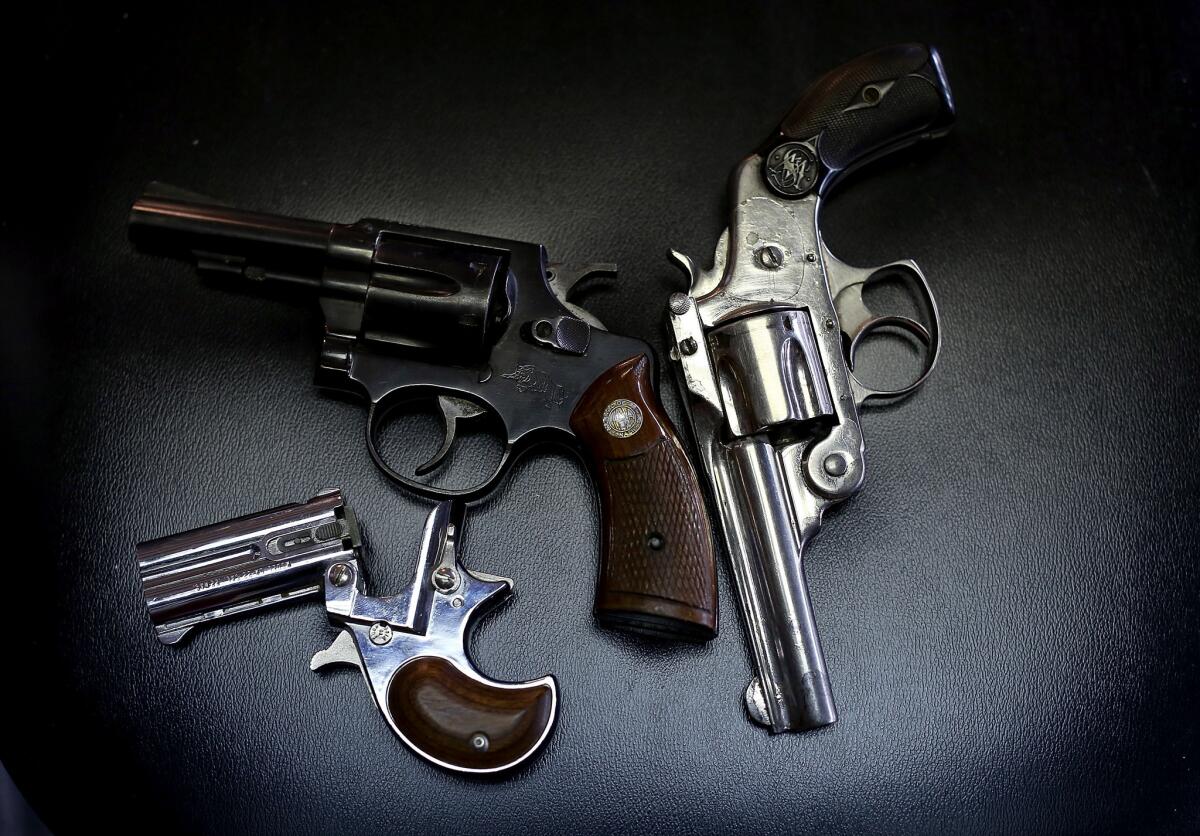Weapons exposure linked to trauma symptoms in U.S. kids, study says

Pistols turned in during a gun buy-back program in Dallas. Researchers said Monday that recent survey data indicated that children who were exposed to violent incidents involving firearms and knives had increased risks of depression, anxiety and other negative mental health symptoms.
- Share via
Exposure to incidents involving guns, knives and other weapons is taking a toll on the mental health of American kids, researchers said Monday — estimating that more than 1 in 4 children ages 6 to 17, a number greater than 17.5 million in all, have been exposed to violence involving a weapon as a victim or as a witness.
About 1 in 33 has been directly assaulted in an incident involving a gun or a knife, they projected.
“This isn’t a rare freak event — it’s a huge public health problem that we’re not taking seriously enough,” said Sherry Hamby, a coauthor of a new study describing the findings, published online Monday by the journal Pediatrics.
Using telephone survey data collected from 4,114 young people in 2011 through the Second National Survey of Children’s Exposure to Violence, Hamby, a research professor in the department of psychology at the University of the South in Sewanee, Tenn., and collaborators at the University of New Hampshire in Durham examined the links between exposure to weapons violence and negative outcomes of trauma in kids (including depression, anxiety and aggression).
In all, 26.5% of surveyed children between the ages of 6 and 17 reported at least one victimization with a weapon — indirectly as a witness, or directly as a target — in their lifetimes. Among children between the ages of 2 and 17, the lifetime victimization rate was 23.9% for boys and 18.4% for girls.
Incidents increased with age and were reported more frequently by children living in households of low socioeconomic status and in “nontraditional families” that did not include two biological or adoptive parents.
Kids who had been exposed to weapons-related violence were more likely to say they had been exposed to gangs in their lives, or to report that they had peers who carried weapons or that they carried weapons themselves. Crucially, they were also more likely to report experiencing life adversity in the last year and symptoms of trauma in the last month than other kids.
Over the course of earlier studies, Hamby said, the researchers had become interested in “poly-victimization,” whereby certain children experienced a larger number of victimizations of many types than others, suffering increased negative effects in proportion with their levels of trauma.
In the current paper, kids who reported exposure to weapons violence were more likely to be classified as poly-victims, with seven or more victimizations in the last year. But even when the researchers took the multiple traumas of poly-victimization into account, exposure to weapons violence was linked to additional depression, anxiety and aggression. “A lot of the burden of trauma that these kids are having is being driven by this exposure to weapons, over and above the other bad things going on in their lives,” Hamby said.
In the past, she added, she and her collaborators had not discovered such a pronounced effect when they looked at the effects of other characteristics of violent incidents, such as whether a parent was involved. Weapons exposure “is one of the few things we’ve found that adds oomph to the trauma outlook,” she said.
Incidents involving highly lethal weapons like guns and knives were more strongly associated with negative outcomes than those involving less-lethal weapons such as sticks or rocks. The researchers also found that, for a child, merely witnessing a weapons-related incident seemed to have a similar effect to being directly threatened. “It doesn’t make a lot of difference whether they’re victimized or they’ve seen someone else be victimized,” Hamby said. “In some cases, it’s even more traumatizing when it’s another family member.”
The coauthors called on the public health community to do more to understand exactly how weapons exposure affects U.S. youths.
Hamby said combating the negative effects identified in the study didn’t have to mean banning guns from American homes. Policies such as requiring trigger locks or storing guns away from ammunition could prevent some of the incidents affecting kids by making it less likely for people to act precipitously in a heated moment.
“A surprising amount of this [violence] is impulsive stuff,” she said. “If you put a lock on a trigger or the ammunition is on the other side of the house, you can go a long way toward giving people the time to count to 10 and emotionally regulate.”
For more on science and health, follow me on Twitter: @LATerynbrown







